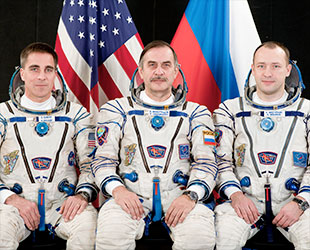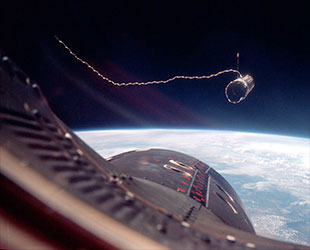March 8, 2013 — NASA astronaut Chris Cassidy is on the fast track to the International Space Station (ISS).
Not only is he and his two cosmonaut crewmates the next in line to fly to the orbiting laboratory, but they will be the first of the space station's residents to arrive on board the ISS on the same day that they launched. Up until to now, the same trip has taken two days.
Set to lift off on Russia's Soyuz TMA-08M spacecraft on March 28 at 4:43 p.m. EDT (2043 GMT) — it will be early March 29 at the Baikonur Cosmodrome, Russia's launch site in Kazakhstan — Cassidy, together with Roscosmos cosmonauts Pavel Vinogradov and Aleksandr Misurkin will reach the station in less time than a typical transatlantic flight.
The six-hour, four-orbit rendezvous isn't without precedent. Most recently, Russia's Progress robotic cargo spacecraft have accomplished the same expedited link up with the space station. But as the first for an ISS-bound crew, the compressed timeline brings with it some advantages — and drawbacks — for Cassidy and his shipmates.

Soyuz TMA-08M crew mission patch. (Spacefacts.de/Roscosmos) |
"From a crew perspective, the advantages are obvious... we're getting to the space station faster and that brings with it a whole lot more comfort than is provided to you in the Soyuz," Cassidy told collectSPACE in an interview on Friday (March 8) from Star City, outside of Moscow. "The Soyuz is a great space vehicle, but it is designed just to get you there and get you back. The creature comforts are not quite the same as what you have on the station, with food, and a bed, your own living quarters, a better toilet and all these things."
"The hard part, I think, is that it will be a long work day," Cassidy added. "But we have those here on Earth and you just kind of get through [it] and deal with a little bit lighter of a day the next day and get on with business."
Compressing and stretching
The Soyuz spacecraft that will take Cassidy, Vinogradov and Misurkin to the station in six hours is no different from the previous Russian capsule that took two days to deliver Canadian astronaut Chris Hadfield, NASA astronaut Tom Marshburn and Russian cosmonaut Roman Romanenko to the orbiting outpost in December.
The six astronauts and cosmonauts will serve together on the ISS as Expedition 35 crew members.

Soyuz TMA-08M crew portrait, from left: Chris Cassidy of NASA, Pavel Vinogradov and Alexander Misurkin of Roscosmos. (GCTC) |
The Soyuz TMA-08M expedited rendezvous relies in part on compressing the schedule of orbital-adjustment engine burns followed by the crew.
"The launch process is the same, you can't really change that," said Cassidy, who on his first spaceflight, a 2009 U.S. shuttle mission, became the 500th person to launch into space. "The whole rendezvous is the same, what we are just missing is spending a night on [the Soyuz]."
The same-day arrival is also made possible by the digital automated systems that were added to the TMA-M series of Soyuz vehicles, as was first introduced in 2010.
"It is the possibility [now] to do a lot on board the vehicle and to calculate the burns so they are not consuming a lot of fuel," veteran cosmonaut Sergei Krikalev, the chief of the Yuri Gagarin Cosmonaut Training Center, explained in a recent press conference.
The shorter schedule translates to a longer time that the crew will be strapped into the Soyuz's snug, custom-fit seats. On the previous two-day trips, once reaching orbit, the crew would shed their Sokol spacesuits and move into the spacecraft's more spacious orbital module, where they could float more freely.
Initially, the thought was that Cassidy and his crewmates would stay seated for the full six hours — in addition to the time strapped into the seats before launch. But the call of nature changed that plan.

NASA astronaut Chris Cassidy prepares to enter a Soyuz trainer at the Gagarin Cosmonaut Training Center in Star City. (NASA) |
"We wind up being in the vehicle for a very, very long time and people just need to use the toilet eventually," Cassidy told collectSPACE.com, "so we'll open the hatch and have access to the БО [Russian Cyrillic, pronounced "bae-oh" meaning orbital module] and be allowed to take our suits not completely off but enough to do any business we need to take care of and just stretch our legs."
For Cassidy, a former Navy SEAL, a little leg room goes a long way.
"For me, that's the biggest thing, stretching my legs," he said. "I'm a little bit taller than is comfortably seated in the Soyuz and after a couple of hours strapped into that seat tightly, it is really, really nice to stretch your legs out."
Trail-blazers
Although the first time for the International Space Station, the Soyuz TMA-08M expedited rendezvous is not the first for the Russian capsule, or for crewed spacecraft.
An earlier version of the Soyuz used batteries, rather than the current solar arrays, to power the vehicle's systems, which meant that the spacecraft needed to quickly reach their destination — the Soviet Salyut space stations of the 1970s — or return to Earth in a matter of days.

An Agena target vehicle as seen from aboard Gemini 11 in 1966. The two spacecraft rendezvoused in one orbit. (NASA) |
Early NASA astronauts also made fast arrivals in space.
Charles "Pete" Conrad and Richard Gordon performed the first direct-ascent rendezvous in history aboard Gemini 11 in September 1966, meeting up with an unmanned Agena target vehicle less than two hours after launching.
Later in the early 1970s, when NASA astronauts flew to Skylab, the United States' first space station, they also reached the outpost on the same day they left Earth. For the orbital workshop, which was severely damaged during its launch, the quicker rendezvous allowed its first crew to carry out the needed repairs.
